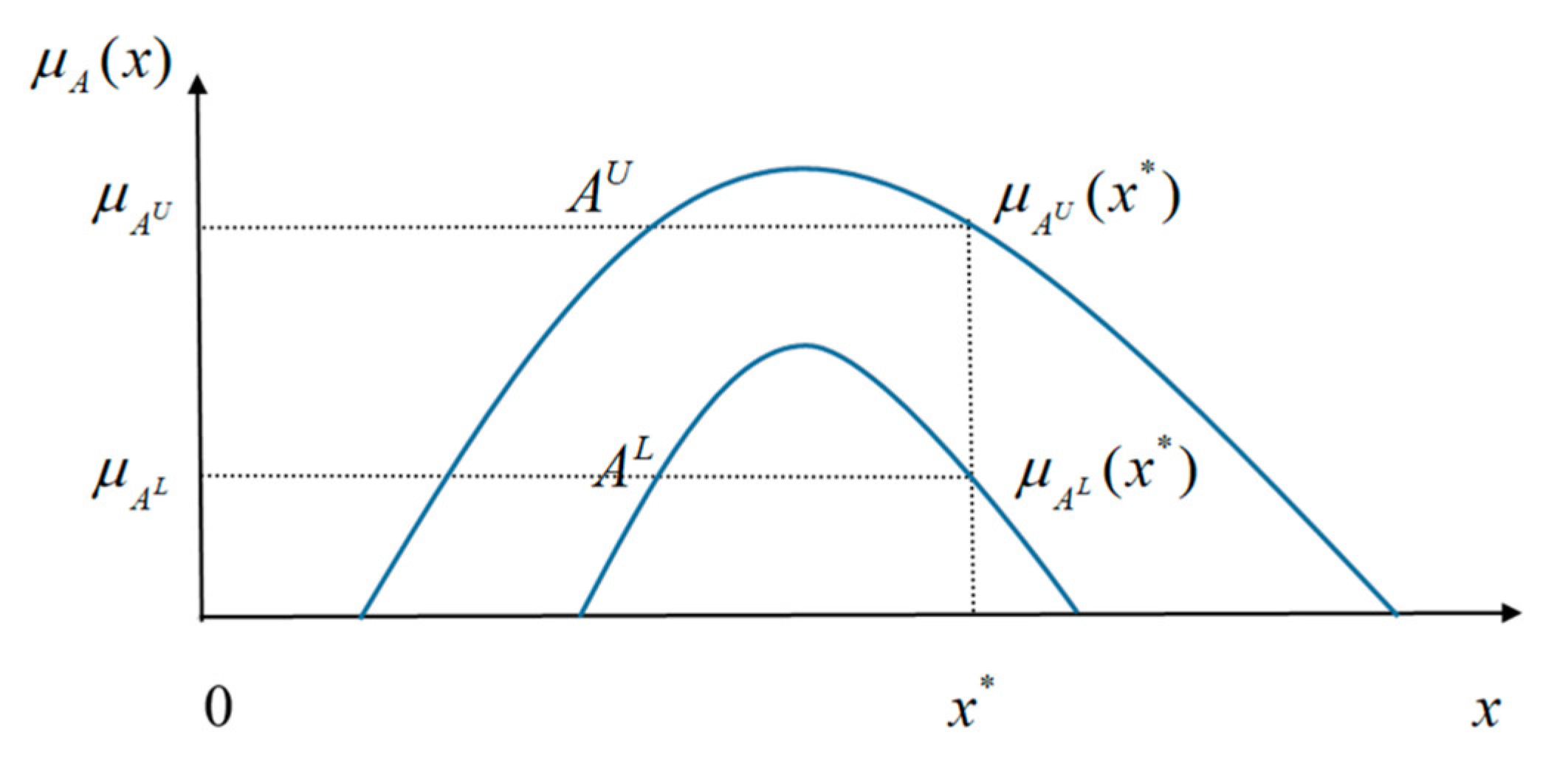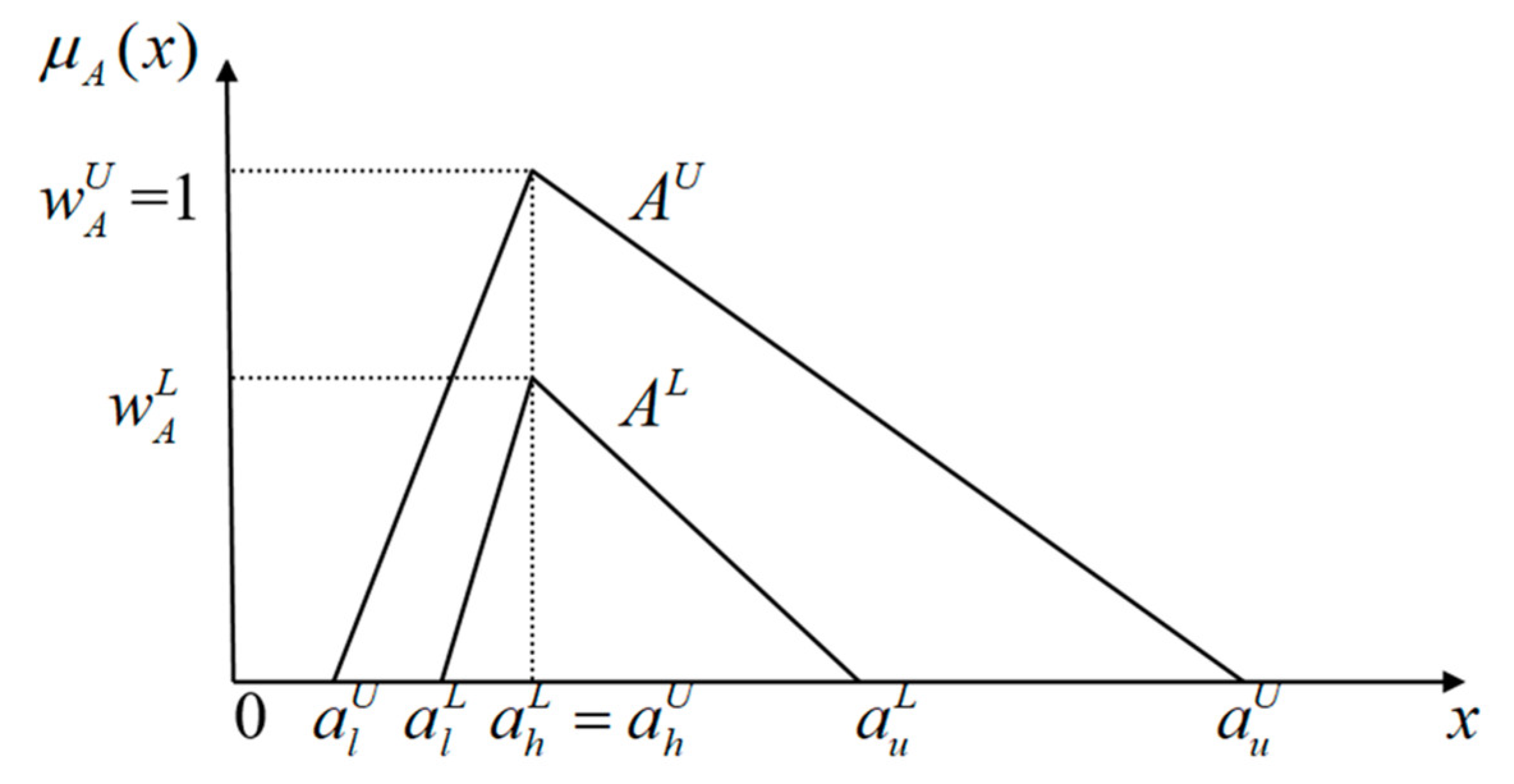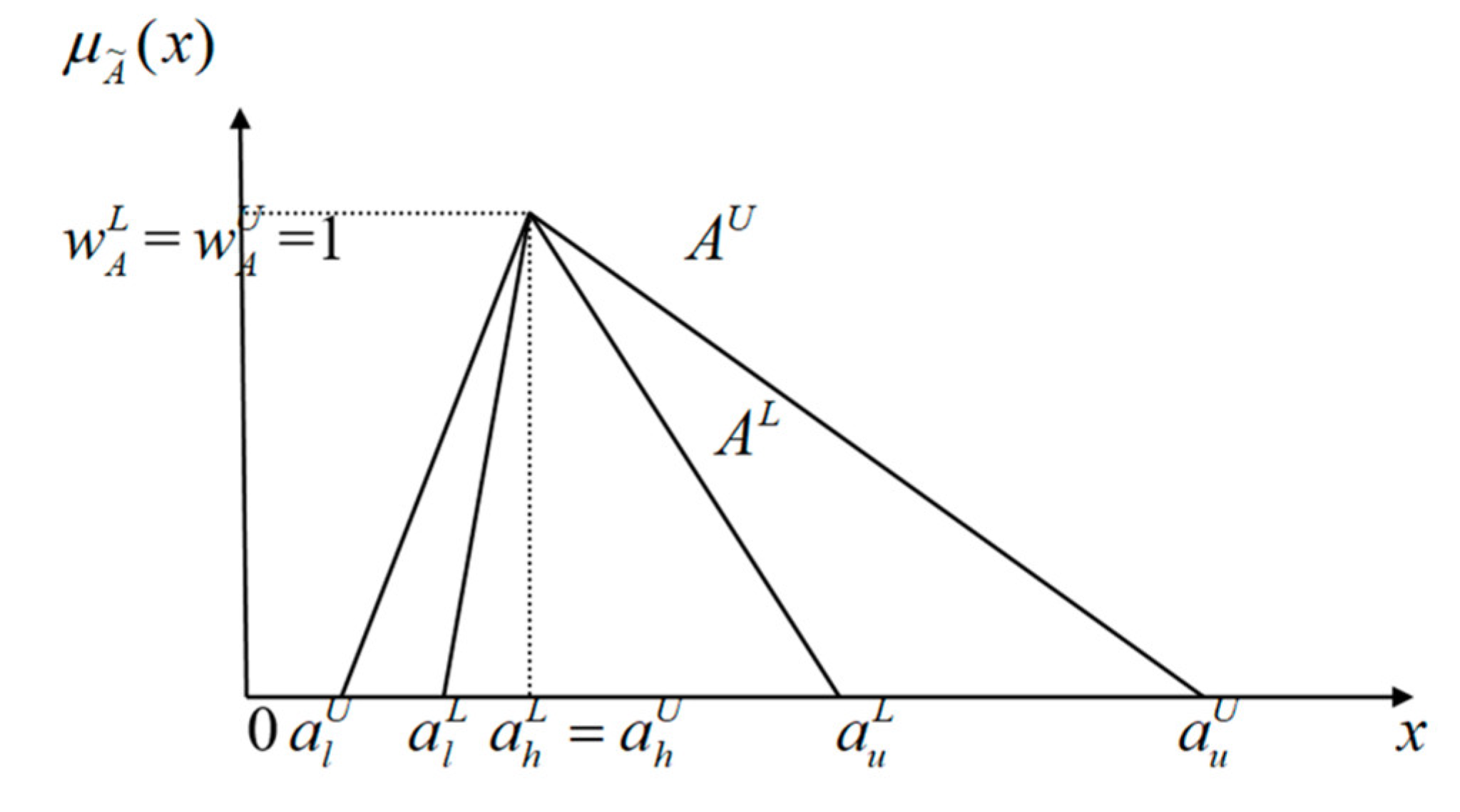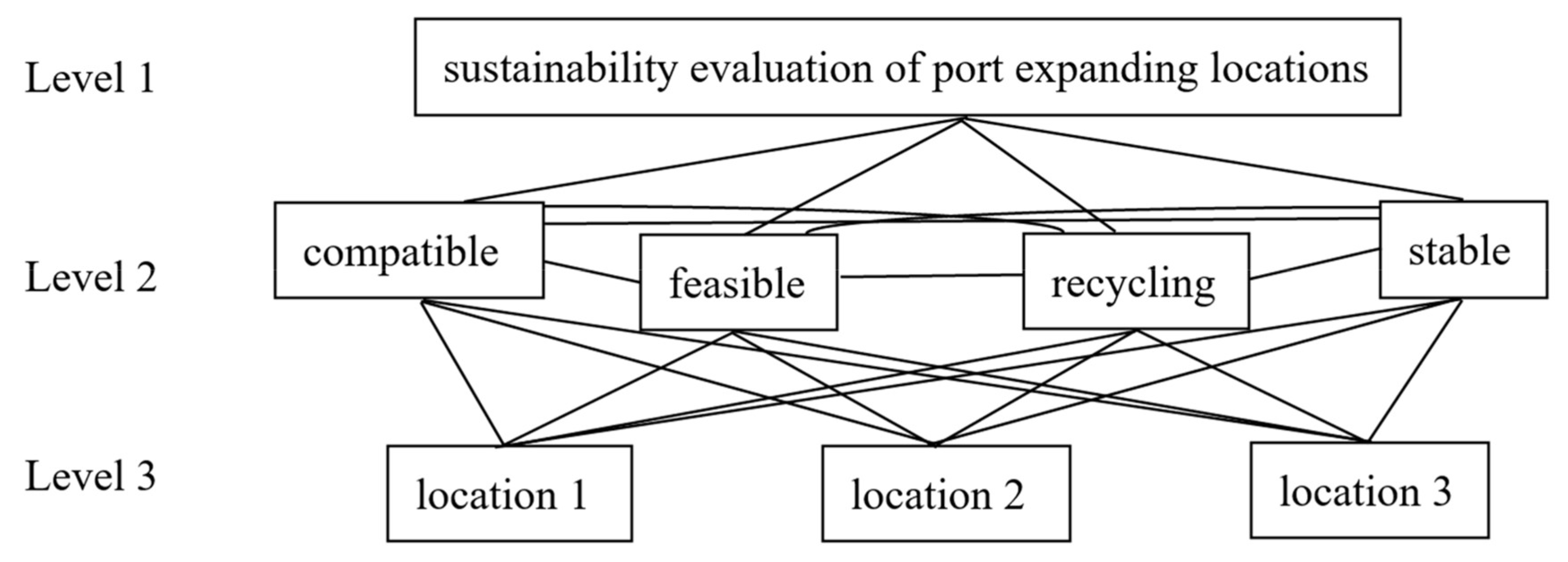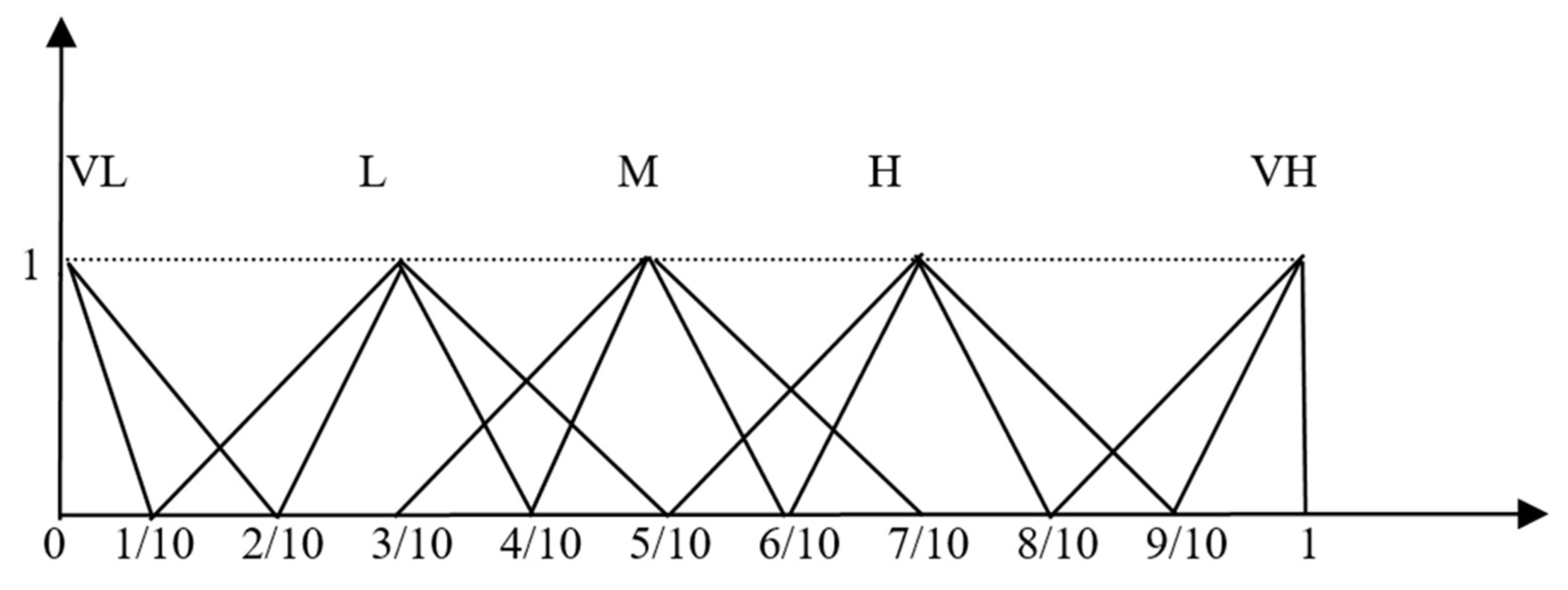1. Introduction
Recently, sustainability has become an essential issue for enterprises due to environmental protection, energy saving, and carbon reduction on a global scale. Therefore, enterprises must implement corporate social responsibility (CSR) with regard to sustainability issues to achieve the requirements of the Earth Summit’s sustainable development goals (SDGs). For instance, giant international ports heavily influence marine pollution owing to their operations; thus, evaluating port sustainability will be important. Basically, evaluating port sustainability is considered from the perspective of three varied quality requirements: environmental, social, and economic [
1]. Criteria ratings of evaluating port sustainability are assessed from the three aspects and thus criteria should be mutually dependent. Additionally, evaluating port sustainability is often undertaken under uncertain environments, and thus this kind of problem belongs to fuzzy multi-criteria decision-making (FMCDM) [
2] with dependent evaluation criteria (DEC). FMCDM is from multi-criteria decision-making (MCDM) [
3] and the fuzzy extension of MCDM. To perform FMCDM with DEC, the analytic network process (ANP) proposed by Saaty [
4] may be extended under fuzzy environments, but there as complicated relationships of hierarchical structure in ANP puzzle decision-makers. On the other hand, the analytic hierarchy process (AHP) [
5] over ANP is easy with respect to computation and realization for decision-makers, but AHP is merely used in MCDM with independent evaluation criteria (IDEC). To utilize AHP in evaluating port sustainability—a FMCDM problem with DEC— AHP is combined with quality function deployment (QFD) [
6] and extended under the interval-valued fuzzy environment (IVFE) [
7]. By the assistant of QFD, the relationships between DEC are presented in FMCDM and related weights of DEC are derived. Then AHP can be utilized in FMCDM with DEC according to related weights of DEC. In other words, combining QFD with AHP under IVFE into a hybrid method will replace ANP to solve the problem of evaluating port sustainability containing sustainability evaluation of port expanding locations. Taiwan is an island country that has only rare resources and a small area, so the gross domestic product (GDP) of Taiwan relies on international trade, hence the importance of international ports. In Taiwan, the international ports are Kaohsiung port, Taichung port, and Taipei port. Evidently, evaluating port sustainability—the FMCDM problem with DEC—is essential and presented as follows.
For evaluating port sustainability, related problems belongs to MCDM [
3] with DEC, among which
were alternatives,
were DEC,
was the rating of
over
, and
was the weight of
for
;
. During alternative ratings and criteria weights assessed in imprecision and vagueness situations, the problems should belong to FMCDM [
2] in MCDM, where ratings and weights are displayed by linguistic terms [
8,
9] and then represented by fuzzy numbers [
10]. In the past, FMCDM [
11] with IDEC was proverbially used, but FMCDM having DEC might be scarcely discussed due to their complicated computations. Recently, FMCDM with DEC have been mentioned, incrementally, owing to their necessary consideration. For identifying relationships of DEC, QFD [
6] is useful, through the connections between quality requirements and function solutions, to gain criteria weights. In QFD [
12], user opinions denote quality requirements, and expert assistants indicate function solutions. The quality requirement priorities of QFD are presented in an important level matrix, and relationships between quality requirements and function solutions of QFD are expressed in a relation matrix. Through the two above matrices, importance and relationship of DEC are connected and then criteria weights are aggregated by QFD. For imprecision, subjectivity, or vagueness data, QFD was expanded into fuzzy quality function deployment (FQFD) [
13] as well; thus, elements of the above matrices in FQFD are expressed by fuzzy numbers. Due to the characteristics of fuzzy numbers, the related computations of FQFD [
14,
15] are complex and it is difficult to combine the important level matrix with the relation matrix. For instance, Liang’s FQFD [
16] had demonstrated the hard computation because the criterion weight was a pooled fuzzy number (PFN) [
10] constructed from the multiplication of two trapezoidal fuzzy numbers (TRFNs) [
17]. Practically, these computations used in interval-valued fuzzy numbers (IVFNs) [
18,
19] will be more complex than others. IVFNs are from interval-valued fuzzy sets (IVFSs) [
20,
21] and utilized in numerous fields [
22,
23]. However, hard operations of pooled fuzzy numbers (PFNs) constructed from IVFNs in generalizing QFD under the fuzzy environment were commonly necessary to derive criteria weights in FMCDM with DEC under IVFE. Therefore, related computations of IVFNs must be mentioned to resolve the ties of PFNs.
Some were devoted to FMCDM with IDEC under IVFE [
7] for grasping more messages than triangular fuzzy numbers (TFNs) or TRFNs, but FMCDM having DEC for IVFNs was still rare. Herein, we generalize QFD and AHP [
5] under IVFE [
20] in FMCDM with DEC for sustainability evaluation of port expanding locations. AHP [
5] was often generalized under fuzzy environment into fuzzy AHP, such as in the approaches of Chang [
24], Zhu, Jing, and Chang [
25], and Wang [
26]. In these above fuzzy extensions of AHP, Chang expressed an extent analysis for FMCDM [
27] constructed on TFNs. Chang’s operations, except for the extent analysis, were the fuzzy improvement of classical AHP [
5,
28] or the application of fuzzy approximate division [
29,
30]. Extent analysis [
24] was the main contribution of Chang, but it had one drawback in computation which made the possibility degrees for fuzzy pairwise comparison ratios confused. Wang [
26] indicated that the possibility degrees attained through Chang’s computation might be negative. Then Zhu et al. [
25] proposed an improvement to the possibility degrees to ameliorate Chang’s drawback. However, the confusion of deriving possibility degrees denoted by Wang still persisted despite the improvement [
26].
To tackle Chang’s and Zhu et al.’s drawbacks, Wang [
26] used representative utility functions [
31,
32] to extend AHP on TFNs. Wang’s method was simpler than Chang’s and Zhu et al.’s on fuzzy computations, but Wang’s was not applying IVFNs [
33,
34]. In addition to above methods, some researchers [
35,
36,
37] generalized AHP under the fuzzy environment by hesitant fuzzy preference relations. The preference relations are utilized to derive priority weights in interval ratios, which are not used in IVFNs. Herein, a utility representative function of IVFNs is applied to compute priority representation vectors of fuzzy pairwise comparison matrices (FPWCMs). Obviously, AHP based on the utility representative function is extended under IVFE into fuzzy AHP in FMCDM. Unfortunately, fuzzy AHP is merely suitable for FMCDM with IDEC, whereas ANP [
4] is a method for DEC. In fact, the difference between AHP and ANP is in their hierarchical structures. The former is used in independent hierarchical structures, but the latter is utilized in dependent hierarchical structures. Evidently, ANP is more complicated than AHP with regard to computation, and thus ANP is also harder in fuzzy extension than AHP. For FMCDM with DEC, QFD combined with AHP in this paper are extended under IVFE to replace fuzzy ANP for the sustainability evaluation of port expanding locations. Through improving Lee’s [
38,
39] extended fuzzy preference relation, Wang [
40] associated QFD with simple additive weighting (SAW) [
41], and Wang et al. [
42] combined QFD with a technique for order preference by similarity to ideal solution (TOPSIS) [
3] for FMCDM with DEC in IVFNs to grasp more messages. In data specifications, SAW and TOPSIS are different from AHP. AHP is used in data consisting of relative ratios, whereas SAW and TOPSIS are utilized in messages composed of general values. In other words, data specification commonly determines the use of decision-making method. For sustainability evaluation of port expanding locations, we associate QFD with AHP to replace ANP under IVFNs due to collected data being relative ratios in a numerical example.
To describe clearly, related notions of IVFNs are shown in
Section 2. In
Section 3, extending QFD and AHP under IVFNs are displayed to FMCDM with DEC for the sustainability evaluation of port expanding locations. Then, a numerical example for the sustainability evaluation of port expanding locations is presented in
Section 4. Finally, conclusions are described in
Section 5.
2. Preliminaries
In this section, related notions of IVFNs [
10] are denoted below.
Definition 1. An interval-valued fuzzy set (IVFS), , according to Gorzalczany [
43]
is defined on as =
, , , , , where is the lower limit of membership degree and is the upper limit of membership degree. In addition, the membership degree of in is expressed by in Figure 1, where and , respectively, denote the minimum and maximum grades of membership in .
Definition 2. A triangular interval-valued fuzzy number(TIVFN), , proposed by Yao and Lin [44] is presented as = = in Figure 2, where and , respectively, indicate the lower and upper parts of the TIVFN, and .
Based on
Figure 3, the related lemmas [
45] of an interval-valued fuzzy number (IVFN),
, are expressed in the following.
Lemma 1. is a crisp value if = = = = .
Lemma 2. belongs to TFNs if = (i.e., = = , = , and = = ). Hence is a triplet .
Lemma 3. = = is a general TIVFN as shown as Figure 3 if = = 1 and .
Furthermore, a general TIVFN,
, has two piecewise linear membership functions
and
defined by
Let be the general TIVFN . Herein, general triangular IVFNs (TIVFNs) are used to express IVFNs on the following computations.
Definition 3. Let = be an IVFN. Then , , , and extended from Lee’s [38,39] are, respectively, displayed as , , , and .
Definition 4. A fuzzy preference relation (FPR) [46,47] is a fuzzy subset of with a membership function representing the preference degree of fuzzy numbers over . (i) is reciprocal if for fuzzy numbers and . (ii) is transitive if and for fuzzy numbers , , and . (iii) is a total ordering relation [48,49] if is both reciprocal and transitive on fuzzy numbers. As is compared with by [12], is smaller than if , whereas is bigger than if . Otherwise, is equal to if .
Definition 5. An extended FPR (EFPR), , is an extended fuzzy subset of with membership function stands for the preference degree of fuzzy numbers over [38,39]. (i) is reciprocal if for fuzzy numbers and . (ii) is transitive if and for fuzzy numbers , , and . (iii) is additive if . (iv) is a total ordering relation if is reciprocal, transitive, and additive. Based on , is smaller than if , whereas is bigger than if . Moreover, is equal to if .
Definition 6. Let and be two general fuzzy numbers. Based on Lee [38,39], the EFPR of over is defined as .
Definition 7. For two IVFNs = and = , the EFPR [40] of over is improved as .
Lemma 4. As = and = are two TIVFNs, the EFPR is yielded as .
Definition 8. Let = and = be two TIVFNs. The addition computation [15] for the two TIVFNs is = .
Definition 9. The multiplication computation [15] of a real number, , and a TIVFN = is = = .
Definition 10. Let be the utility representative value of an IVFN, , constructed on a utility representative function and presented as = = .
Lemma 5. Let be the utility representative value of a TIVFN = from . Based on Definition 10, = = . As is a crisp value expressed by an IVFN , is equal to (=). It is said that the utility representative function can be also used in crisp values.
Definition 11. For IVFNs , their sum is defined as , where , being the sum computation of fuzzy numbers, is discriminated from , being the sum computation of crisp values.
3. QFD and AHP Extended under IVFE for Sustainability Evaluation of Port Expanding Locations
To FMCDM with DEC, QFD and AHP are extended under IVFE for the sustainability evaluation of port expanding locations. Related computations are expressed below.
In the interval-valued FMCDM problem, weights of DEC (i.e., technical solutions) can be yielded by extending QFD under IVFE. are quality requirements assessed through users, and is a fuzzy important level of quality requirement evaluated by the th user, where ; . is fuzzy important levels of after aggregating the opinions of all users. Thus, = , , and then = is a fuzzy important level matrix.
In QFD, weights of DEC are gained by associating
with a relation matrix
that expresses the relationships between quality requirements over function solutions. To the relation matrix
,
evaluated by the
th expert indicates the fuzzy relationship strength rating for
over
, where
;
;
. Then,
=
is the mean of relationship strength rating for
over
,
. In addition,
represents the relation matrix for quality requirements over function solutions after aggregating all experts’ opinions. Based on the above,
is yielded by generating QFD under fuzzy environment into a weight matrix, and thus
where
Practically, multiplying two fuzzy numbers [
50] would form a PFN. In generalizing QFD under fuzzy environment, corresponding computations of PFNs may be necessary but complicated, especially for the environment constructed on IVFNs. For instance,
=
and
=
,
.
=
,
. Moreover, the membership function of
[
40] is presented as
where
, ,
,
, ,
, ,
, ,
, ,
, .
Based on above, the PFN
would not be a TIVFN. It is evident that corresponding computations of PFNs for FMCDM are hard. To resolve the hard computation above, the EFPR values (i.e., utility representative values) of the fuzzy important levels over their comparison basis are substituted for the fuzzy important levels in quality requirements. Due to
(
) > 0, the common comparison basis of the preference relations for IVFNs is assumed as 0. The utility representative value of
yielded as
=
denote the preference degree of
over 0,
. Through the relative preference degrees of fuzzy important levels over 0,
is assumed to be the adjusted fuzzy weight matrix for yielding DEC, and thus
where
=
,
.
is a TIVFN due to being a crisp value and being a TIVFN . Then, the adjusted fuzzy weight , being a TIVFN, is recognized as the representation values of and used in interval-valued FMCDM with DEC, .
The utility representative function
in previous descriptions is utilized for adjusted fuzzy weights, and also used in extending AHP under the fuzzy environment. In fuzzy extension of AHP, yielding priority vectors of FPWCMs for weights are critical, but related works are hard. Herein, the priorities from the fuzzy pairwise comparison matrix (FPWCM) of IDEC based on evaluation objective are unnecessary because adjusted fuzzy weights are gained for DEC. Practically, ANP [
4] is more suitable than AHP [
5] for the consideration of DEC. However, the fuzzy extended computation of ANP is very complicated. Hence, the computation of QFD is substituted for yielding priorities of pairwise weight comparison matrix in AHP. For traditional AHP, several approximating solutions [
5], including normalization of row arithmetic averages (NRA), were proposed to derive the eigenvector of AHP. These approximating computations might be easy in obtaining the eigenvectors of pairwise comparison matrices; however, extended under fuzzy environment, they were still complicated and hard. For instance, the simplest NRA of the approximating solutions extended under fuzzy environment expresses the computation difficulty. Hence, the other approximating computations will be also hard, and related demonstrations are presented as follows.
For sustainability evaluation of port expanding locations, let
Be a
pairwise comparison matrix for
alternatives (i.e., locations) based on the
th criterion in AHP, where
=
denotes the rating ratio of location
over location
based on criterion
, and
for
;
;
. In NRA [
5], the
th priority
of
is computed as
. The computation is difficult as the process is transferred in extending AHP under fuzzy environment. Herein,
=
is a FPWCM of locations based on the
th criterion, and
stands for the
th fuzzy priority in
. For NRA being extended under fuzzy environment,
=
, where
denotes the fuzzy rating ratio of location
over location
based on criterion
, and
=
,
. Due to
being a fuzzy number, both
and
are fuzzy numbers as well. Based on the above,
derived is hard because addition and division of fuzzy numbers are not easy,
. Despite approximating computation, division for fuzzy numbers does not exist truly. Therefore, the utility representative function of
Section 3 is also used in approximating computations of NRA to yield the priorities of FPWCMs because
is fuzzy multiplication, similar as Chou’s [
32] multiplication operation, where
is the multiplicative inverse of
.
Based on the above, Wang [
26] proposed the representative utility function for NRA computation about TFNs. Similar to Wang’s computations, the priority representation
through the utility representative function is
with
being an IVFN stands for the rating ratio of location
over location
based on criterion
in the corresponding FPWCM,
. Let
=
—that is the transpose of
—be the priority representative vector composed of
,
. In addition, the priority representative matrix
is formatted as
With
and
, the alternative performance indices are derived. Let
=
be the performance index vector, where
is the transpose of
. Let
where
=
is the performance index of alternative
,
. Due to
,
, …,
being IVFNs, alternatives are ranked according to
,
,…,
. Then, extending QFD and AHP under IVFE for sustainability evaluation of port expanding locations is finished because the optimal alternative is determined.
Moreover, preference consistency [
51] of FPWCMs was important. Hence, Wang’s [
17] consistency computations of IVFNs are applied to yield the consistency test of FPWCMs in this paper. To the consistency test, the consistency ratio (CR) indicates the ratio of consistency index (CI) over random index (RI). For AHP [
5], the values of RI based on varied ranks are presented in
Table 1 below. Commonly, CR < 0.1 denotes that the pairwise comparison matrix conforms to preference consistency.
Through Wang [
17], CI between criteria and locations for criterion
is yielded as
and
. Moreover,
,
. Then CR of the whole hierarchy (i.e., CRH) is derived as CRH =
. As CRH < 0.1, the related FPWCMs for sustainability evaluation of port expanding locations conforms to preference consistency of the whole hierarchy. Generally, weight consistency of pairwise comparison matrices in CRH should be also taken into consideration for AHP. However, the weights of DEC had derived by extending QFD; thus, the weights are not considered in CRH of extending QFD and AHP for FMCDM with DEC.
4. Illustrating Example for Sustainability Evaluation of Taipei Port’s Expanding Locations with DEC
In Taiwan, three main harbors are Kaohsiung port, Taichung port, and Taipei port. For these harbors, Taipei port, established in 1993, is relatively new compared to the others, and thus numerous corresponding expansions are necessary. To Taipei port’s expanding on sustainability, three candidate locations based on criteria are assessed. In QFD, three fundamental aspects are recognized as quality requirements being environmental (
), social (
), and economic (
), evaluated by thirty professional users, and
are, respectively, the fuzzy importance levels of these requirements. Herein, criteria are considered to be four function solutions that are compatible (
), feasible (
), recyclable (
), and stable (
), employed by ten experts. The function solutions and the previous quality requirements are tightly connected, as shown on
Figure 4. to indicate the relationships between DEC. Moreover, corresponding fuzzy weights
are yielded in the sustainability evaluation problem of candidate locations for Taipei port’s expanding.
Based on the above, the related hierarchical structure is presented in
Figure 5, where sustainability evaluation of port expanding locations is denoted in Level 1, DEC are indicated in Level 2, and candidate locations are displayed in Level 3. According to the hierarchical structure for the sustainability evaluation of port expanding locations, it is evident that the four evaluation criteria are dependent. AHP is not enough to resolve the sustainability evaluation problem with dependent criteria, whereas ANP may be used in the situation. However, ANP is more complicated than AHP on computation, and experts take much time to determine relative weights in the rating process. To simplify computations of DEC for experts, QFD is combined with AHP for replacing ANP on sustainability evaluation of port expanding locations. Further, DEC compatible, feasible, recycling, and stable are conceptualized functions. In fact, these DEC, through the system analysis assistant, can be subdivided and added according to the necessary experts. In other words, these DEC are conceptually formed and flexibly adjusted to conform to the requirements of evaluation.
Through QFD, importance levels are measured from a linguistic term set {very low (VL), low (L), medium (M), high (H), very high (VH)}. These linguistic terms and corresponding IVFNs are shown in
Table 2. In addition, linguistic assessments employed through professional users containing crews of harbors, shipping companies, and shipping agents are displayed in
Table 3, and fuzzy importance levels of quality requirements according to entries of
Table 2 and
Table 3 are aggregated in
Table 4. Moreover, the relationships between IVFNs of
Table 2 are shown in
Figure 6.
Through entries of
Table 4, utility representative values of fuzzy importance levels are computed in
Table 5.
Herein, linguistic relationship strength assessments for quality requirements over function solutions are shown in
Table 6, and the table is gained by experts containing managers of harbors, shipping companies, and shipping agents through the previous linguistic term set. Then, linguistic relationship strength ratings of
Table 6 are derived to construct a relation matrix. This is presented in
Table 7.
As the adjusted fuzzy weight matrix is yielded, the opinions of related users in the available questionnaires are indicated by pairwise comparison ratios that are absolute unimportance (=1/9), very strong unimportance (=1/7), essential unimportance (=1/5), weak unimportance (=1/3), equal importance (=1), weak importance (=3), essential importance (=5), very strong importance (=7), and absolute importance (=9). Then, the pairwise comparison ratios are aggregated into TIVFNs shown in FPWCMs of candidate locations based on evaluation criteria. For the FPWCM of candidate locations, let
denote the relative rating ratio of location
over location
based on criterion
employed by the
th user,
. The converting formula, through sample mean and sample standard deviation [
52], is indicated as
where
In addition,
expresses the multiplicative inverse of
, where
;
;
. As
= 190, four FPWCMs representing these candidate locations of port expanding based on four criteria including compatible, feasible, recycling, and stable items are indicated as
Table 9,
Table 10,
Table 11 and
Table 12, respectively.
According to entries of the four tables above, the priority representation vectors of three port expanding locations based on compatible, feasible, recycling, and stable items are, respectively, derived as (0.4117,0.3223,0.2661)
, (0.3978,0.3234,0.2788)
, (0.3804,0.3204,0.2991)
, and (0.4180,0.3212,0.2608)
. Moreover, CI = 0.0070 and CR = 0.0121 < 0.1 for the FPWCM of three locations based on compatible item, CI = 0.0072 and CR = 0.0124 < 0.1 for the FPWCM of three locations based on feasible item, CI = 0.0084 and CR = 0.0145 < 0.1 for the FPWCM of three locations based on recycling item, and CI = 0.0073 and CR = 0.0125 < 0.1 for the FPWCM of three locations based on stable item. Evidently, these FPWCMs conform to preference consistency. Then, CRH is yielded as
Therefore, the whole hierarchy for the sustainability evaluation of port expanding locations satisfies preference consistency as well.
From the entries of
Table 8 and the priority representation vectors of three port expanding locations based on four sustainability evaluation criteria, the performance indices are derived as
The ranking result of three candidates is
>
>
, owing to the representation values of above performance indices for the sustainability evaluation of port expanding locations. Obviously, location 1 is the best one with respect to the sustainability evaluation problem. Moreover, the sensitivity analysis of adjusted weights, according to the above computations, is yielded from a linear programming model as follows. The model is formatted as
To avoid criteria weights being 0, four constraints of adjusted weight values on utility representative function are added. Hence, the scopes of
,
,
, and
are, respectively, 0.4652
0.1, 0.4550
0.1, 0.4053
0.1, and 0.4648
0.1. Then sensitivity analysis of adjusted weights yielded by the sensitivity report of Excel 16.0 is presented in
Table 13.
Through the entries of
Table 13, it is obvious that the original values of adjusted weights on utility representative function are stable because these allowable increase and allowable decrease values are almost fixed. In fact, the stable situations are also shown in the tolerance values. For instance, the scopes of
,
,
, and
are revised as 0.4652
0.4, 0.4550
0.4, 0.4053
0.4, and 0.4648
0.4. That is to say, four constraints of adjusted weight values on utility representative function are 0.4652 − 0.4
0.4652 + 0.4, 0.4550 − 0.4
0.4550 + 0.4, 0.4053 − 0.4
0.4053 + 0.4, and 0.4648 − 0.4
0.4648 + 0.4. At that time, the sensitivity analysis of adjusted weights yielded by the sensitivity report of Excel 16.0 is expressed in
Table 14.
Similar to
Table 13, these allowable increase and allowable decrease values in
Table 14 are the same entries as well. Practically, the hybrid method combining QFD with AHP under IVFE is compared with other FMCDM ones presented in the following
Table 15.
Through comparisons of
Table 15, it is evident that characteristics of the hybrid method are suitable to FMCDM with DEC and used in relative ratios. Although the method may not the simplest one for operations due to combination of QFD and AHP, easier single methods are utilized in FMCDM with IDEC. Moreover, the time complexity for fuzzy computation to yield the priority representations of
FPWCMs is
for IVFNs by the utility representative function, similar to that of Wang [
26] for TFNs, whereas the time complexity of Chang’s method [
24] on fuzzy computation is
for TFNs. As
is a positive integer,
. Hence, a hybrid method combining QFD with AHP under IVFE is better than Chang’s with respect to the time complexity for fuzzy computation and is able to be used for IVFNs.
